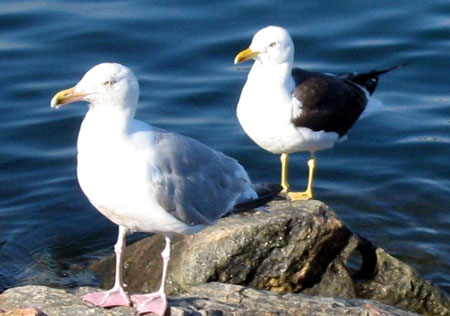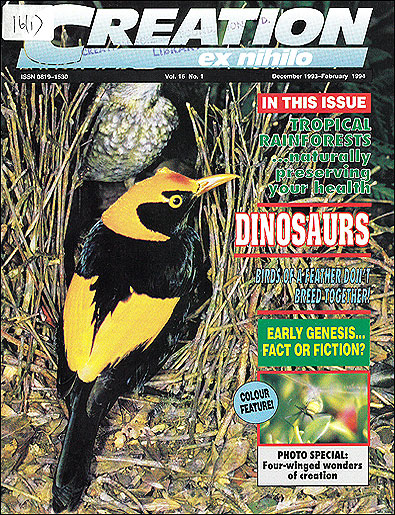Birds of a feather don’t breed together

The fascinating phenomenon known as ‘ring species’ is sometimes quite incorrectly used to ‘prove’ evolution. The classic example is as follows.
In Britain, the herring gull is clearly a different species from the lesser black-backed gull. Not only can they be easily told apart, but apparently they never interbreed, even though they may inhabit the same areas. By the usual biological definition, they are therefore technically different species.
However, as you go westward around the top half of the globe to North America and study the herring gull population, an interesting fact emerges. The gulls become more like black-backed gulls, and less like herring gulls, even though they can still interbreed with herring gulls from Britain.
Now go still further via Alaska and then into Siberia (see map). The further west you go, the more each successive population becomes less like a herring gull and more like the black-backed.
At every step along the way, each population is able to interbreed with those you studied just before you moved further west. Therefore, you are never technically dealing with separate species. Until, that is, you continue your journey into Europe and back to Britain, where you find that the lesser black-backed gulls there ‘are actually the other end of a ring that started out as herring gulls. At every stage around the ring, the birds are sufficiently similar to their neighbours to interbreed with them.’1 Yet when the ends of the ring meet, the two do not interbreed and so are for all intents and purposes separate species.

As you travel west via the route shown by the yellow band, each successive population of herring gull seems more like the black-backed gull.

Evolution?
It is clear from such examples that species are not fixed and unchanging, and that two apparently different species may in fact be genetically related. New species (as man defines them) can form. The herring gull and the lesser black-backed gull could not have been initially created as two separate groups reproducing only after their kind, or else they would not be joined by a chain of interbreeding intermediates.
There are also observations of other wild populations from which a reasonable person must infer that certain very similar species did indeed share the same ancestor, even though there is no complete ‘ring’.
Many have been misled into thinking this is evidence for evolution and against biblical creation. However, some thought reveals otherwise. The key to understanding this is to consider the vast amounts of complex information in all living things, coding for functionally useful structures and processes.
Creation as described in the book of Genesis implies that virtually all the genetic information in today’s world was present in the beginning, contained in separate populations (the original created kinds).
This information would not be expected to increase, but could decrease with time—in other words, any genetic changes would be expected to be informationally downhill.
Evolution (in the normal meaning of the word) implies on the other hand that a single cell has become people, pelicans and palm trees. If true, then this is an uphill process—involving a massive increase of information.2
Change—but what sort?
The formation of new species actually fits the creation model very comfortably. The wolf, the dingo and the coyote are all regarded as separate species. However, they (perhaps along with several other species) almost certainly ‘split off’ from an original pair on the Ark—a species representing the surviving information of one created kind. Is there evidence that this can happen, and that it can happen without adding new information, that is, within the limits of the information already present at creation?
A ‘mongrel’ dog population can be ‘split’ into separate sub-groups, the varieties of domestic dog (breeders can isolate portions of the total information into populations which do not contain some other portions of that information). This sort of variation does not add any new information. On the contrary, it is genetically downhill. It involves a reduction of the information in each of the descendant populations compared to the ancestral one. Thus, a population of pampered lap-dogs has less genetic information/variability, from which nature or man can select further changes, than the more ‘wild’ population before evolution selection took place.
But is it conceivable that such change (which is obviously limited by the amount of information already present in the original kind) can extend to full, complete formation of separate species without any new information arising, without any new genes? (In other words, since evolution means lots of new, useful genes arising with time, can you have new species without any real evolution?)

Richard Lewontin is Alexander Agassiz Professor of Zoology at Harvard. In his book The Genetic Basis of Evolutionary Change he says there are instances in which ‘speciation and divergence of new full species’ have obviously occurred using ‘the available repertoire of genetic variants’,3 without requiring any ‘novelties by new mutation’. In other words, an ancestral species can split into other species within the limits of the information already present in that kind—just as creationists maintain must have happened.4
In the example we looked at, there is no reason to believe that the differences between the two gull species are the result of any new, more complex, functional genetic information not already present in an ancestral, interbreeding gull population. Because there is no evidence of any such information-adding change, it is misleading to say this gives evidence of evolution, of even a little bit of the sort of change required to eventually turn a fish into a philosopher.
Ring species and similar examples actually highlight the great variety and rich information which must have been present in the original created kinds.5 They can be said to demonstrate evolution only to the gullible (pun intended).
References and footnotes
- New Scientist, 5th June 1993, p. 37. Return to text.
- See C. Wieland, ‘Variation, Information and the Created Kind’, Journal of creation 5(1):42–47, April 1991. The usual mechanism proposed is the cumulative selection of ‘uphill’ copying mistakes. However, the observational evidence for such information-adding mutations (as opposed to the occasional loss/defect giving survival value—e.g. eyeless fish in caves) does not appear to exist. On information-theoretical grounds one would expect them to be vanishingly rare if not non-existent. Return to text.
- Columbia University Press, 1974, p. 186. Lewontin refers to ‘new mutations’, as he believes that all existing variation came about by copying accidents (‘old mutations’) in the first place. However, that is belief, not observation. Note that a ‘downhill’ mutation can theoretically cause a reproductive barrier (and speciation) without adding any new, functional information. Return to text.
- For evidence that this can happen very rapidly, see ‘Darwin’s finches—evidence of rapid post-Flood migration’, Creation 14(3):22–23, June–August 1992. Return to text.
- It requires enormous amounts of variation to be already present for selection to result in ‘new’ types. A farmer cannot select for bigger eggs from his hens unless the information for this is already in the genes of some of them. Note that the common ancestor of these two gull species was likely already split off from (and genetically depleted compared to) the original kind. Return to text.














Readers’ comments
Comments are automatically closed 14 days after publication.